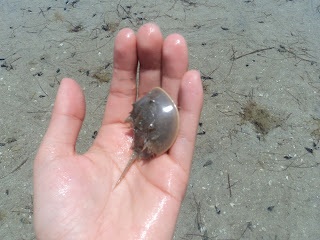Center
for Marine Tropical Ecology
University
of Bremen, Germany
The Smithsonian
Marine Science Station in Fort Pierce in Florida is one of those places where
research
is done in style.
I
visited the Smithsonian Marine Station in Fort Pierce in Florida, for the first
time on July 2011. It
was a
great experience for me. Besides research work, I had the opportunity to meet
new people
and
visit new places. It was also the first time that I saw a live horseshoe crab,
something very
amazing!
My main goal during 2011 (besides research work) was to see a manatee. I had heard
 |
| My first Horseshoe crab |
My main goal during 2011 (besides research work) was to see a manatee. I had heard
about
them many times but I had never seen them myself.
I
returned to the Marine Station a second time during July 2012. I had to work
intensively with our
Crepidula
snails doing the bead feeding experiment, making videos of bead feeding, and
helping
out with
other experiments at the same time.
The
species that we used were: C. ustulatulina, C. atrasolea, C. depressa, C.
fornicata, and B.
calyptraeformis.
These species are usually pretty easy for us to find, except we have always had
a little
trouble finding C. ustulatulina because they are smaller and the population
seems to be
reduced
in some areas.
On our
official first day of work Dr. Collin, 2 friends, and I went kayaking (yes,
kayaking - what
an
amazing job) in a beautiful place surrounded by mangroves. We saw small sandy
islands,
dolphins
and the biggest surprise “the adorable manatees”. They were swimming around our
kayaks
for a couple of minutes. There were three of them, I suppose: a mom, a dad and
a baby. I
can’t
describe how I felt during that moment; I was like a kid and her candy. I would
say that the
manatees
are not the most beautiful creatures I’ve ever seen, but in some way they are
special for
me!
We
continued kayaking and somebody said, “Hey can we make a short stop here? This
looks
them (glass) we also found them attached to shells.
 |
| Small Crepidula attached to the bottle |
 |
| Crepidula's attached to a shell |
We also went to Sebastian Inlet to collect some Bostrycapulus on the rocky shore. It was little but
difficult
to get them, because they are attached to big muddy rocks, and the murky water
made it
hard to
see even a short distance underwater.
Lastly,
we went to the Harbor Branch Oceanographic Institute to search for a few more
C.
ustulatulina.
Between the best friends of a good friend, “the mosquitoes”. There were a lot
of C.
ustulatulina!
After
around 4 hours of kayaking, being with manatees, collecting snails, and of
course a new sun
tan, we
were ready for the next part of the schedule: lab work.
Besides
work, there was always time to get some good U.S. beer and have some food. I
tried the
gator
bites at the restaurant next to the hotel we were staying in, I really like it,
it was the first
time I
had had alligator meat… and no, it didn’t taste like chicken.
I loved
going to the market on Saturday morning. There you can have good food and
beverages,
and we
also bought some puppy treats! My beautiful dog “Tekila”, loved the baked
cookies
flavored
with bacon and cheese.
During
the stay at the Marine Station, you have the opportunity to meet many
scientists and to
learn
something new. The Station’s staff and scientists are very welcome and very
helpful.



No comments:
Post a Comment